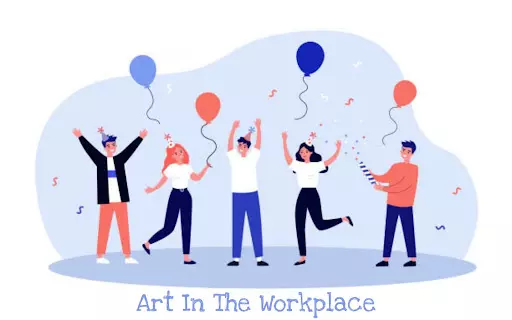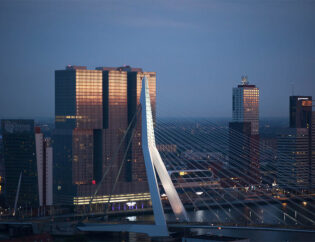
Excerpt: Jobs are no more a simple way to earn money. Jobs are much more than that now. But with a hectic schedule and lots of work, even the best jobs at times get into nerves. Hence most people search for peace of mind in their jobs. In this article, we will see how art is a subtle technique to improve many employees’ current state of mind regarding their jobs and workplace environment.
Read Time: 16 mins
It is no longer simply about the necessities to live and work in today’s world. We appear to stretch for more and more since everything is at our fingertips.
These days, we all want to stand out from the crowd, soar above the mundane, push past our boundaries, and to reach new heights.
Instead of working to survive, most of us now work to live and admire nature, travelling and of course, art.
Do we need to get on the move to feel completely satisfied?
Probably yes, but today, the corporate world is going through a fast-paced renaissance, doing its best to enable its employees to find inner satisfaction, even during 9-5 workdays and art adds enormous value to it.
Even though we are moving away from cruel factory halls and unpleasant work environments as a result of exponential technological advancement, there is still much work to be done to restore the balance between work environment and quality of life.
Art is a subtle approach to improve many employees’ present state of mind about their jobs and workplace surroundings, because, let’s face it, even the best job in the world can get on your nerves at times.
Could a small investment in art enable businesses to incorporate culture, express brand values, raise productivity, improve employee engagement, reduce stress, and make the workplace more pleasant?
Forms/Types of Art in the Workplace

There are a few things to keep track of, starting with the adoption and implementation of art in your workplace.
Art can be found in several forms all around us.
We use our senses to observe various forms of art, and we occasionally use more than one.
If you’re thinking of putting art in your office, there are three things to keep in mind.
Which of your senses would you like to trigger?
Which types of art are most appropriate for conveying the message you wish to send?
What are your goals and how do you plan to attain them?
Architecture, sculpture, painting, literature, music, performing arts, and film are important genres of art to include in the workplace.
Because art is sometimes all about crossing the limits, one should never be afraid to be slightly edgy while choosing the correct piece of art.
Rely on the power of art to challenge a person, transmit a message, provoke a different way of thinking, and intrigue, while also refreshing the atmosphere, influencing a person, and shaping the environment. It isn’t art if it leaves a person indifferent.
When it comes to an artist’s independence, whether the recipient is shocked or annoyed, satisfied or befuddled, or spurred into thinking or feeling, is less important than the fact that he is touched.
When it comes to using art in business, it’s important to take caution and be aware of the impacts that will be produced.
Although each work of art can be utilized for the same goal, there is virtually always one piece that symbolizes the ideal answer for the desired results.
Impact of Art on Employees

Hard labor, weariness, tension, employee interaction, creativity, and productivity all combine at the workplace to create a unique environment. Consider the impact you may have by simply infusing some artistic creativity into your company’s culture.
Employees are the backbone of any organisation. Every business must nurture its employees and do all possible to ensure that they are having a good time while at work.
Consider art to be a valuable asset in your toolkit, whether your staff know what they require or you are the one in charge.
By interviewing approximately 2,000 UK office workers and analysing the average timeframe of efficient work, VoucherCloud arrived at an odd result.
They discovered that just 2 hours and 23 minutes of an 8-hour workday were spent productively on work, with the remainder spent on activities such as news and social media checking, food and hot beverage preparation, non-work-related subjects with coworkers, and so on.
Work and non-work activities take up approximately the same amount of time.
Based on this, art may be used in two ways to affect people at work: active and passive.
Active Influence of Art on Employees

Employees in their “barely-working” hours are affected by this type of influence. Given the importance of this time as compared to their working hours, there is a significant risk of the employees being affected.
The boss has complete control over his or her inventiveness, as well as the attention of employees whose minds are otherwise occupied.
Art should be used to stimulate, refresh, and renew employees throughout this period.
Taking a stress-relieving break and returning to work with renewed vigor and focus can significantly boost the firm’s production.
The most appropriate arts to use here are those that do not overburden employees’ attention spans, which are already strained by the tasks at hand and the plethora of stimuli found in today’s workplaces. Paintings, sculptures, short video clips, and music should suffice.
Passive Influence of Art on Employees

Working hours can be long and monotonous, and working in unfavorable settings can also be a problem.
A passive reception and consumption of art is the greatest way to address this issue. Music, architecture, wall graphics, and other subtle art expressions are powerful ways to revitalise the workplace and group atmosphere.
In this instance, talking about art could be misinterpreted and perceived as trivial.
As previously stated, the passive influence of art is all about its unobtrusive inclusion into the workplace, which opens up a whole new world of creative possibilities for the employer.
Aside from traditional art, there is a broader range of artistic applications that can be made in the workplace.
Table tennis, for example, isn’t exactly a work of art, but the creative ideas for repurposing it as a work desk elevates the standard to a whole new level. It takes on a life of its own.
The formation or representation of strong company culture can be achieved through the incremental refurbishment of the workplace using unusual concepts.
Starting with tiny, but well-planned and targeted communal activities, one can see an increase in productivity and staff consolidation.
Strengthen Brand Culture with Art

There is a huge universe of people who regard workplace art as “merely aesthetic,” but aesthetics encompasses so much more than most people believe.
It’s not only about looking good on the surface. Aesthetics is concerned with wholesome, artistic beauty, and in order to achieve so, it must also consider inner beauty.
In terms of a less aesthetic discourse, inner beauty could be considered content.
As a result, art isn’t only a style or a form. It’s all about getting content out there.
With this in mind, art can be used to stimulate employee perception, interaction, engagement, and a specific frame of mind.
Great companies include art into their interior design plans.
We’re not just talking about wall graphics, photographs, sculptures, or living walls; we’re also talking about modern solutions like graffiti.
Every serious organisation should think about how it presents itself to its employees and associates through art.
Those who look after the workplace environment and style it to match employee expectations are telling them that they are willing to go above and beyond to meet their needs for a pleasant atmosphere or how much attention is paid to how they feel at work.
If a picture is worth a thousand words, you’d better watch what your company’s walls say to its employees.
Avoid simple walls, as they imply that there is no storey to tell or a promising future for the ambitious.
Companies that pay attention to those things and create a welcoming environment are more likely to have happy employees who are proud of their jobs and enjoy what they do. Messages, colours, and other works of art could also be used to convey business values.
Tina Baker of the Witherstech legal company believes that art should be equally present in offices, residences, and public settings to enhance everyday relationships. She was conscious of the bad stereotypes that law firms face when she created Witherstech, so she chose to play the cards differently and add some “colour splash” to the walls.
When it came to furnishing workplaces with creative goods, she went the extra mile and outfitted Witherstech with electric works of art, which was unique for a company of its size.
By refreshing the workplace, she was able to set her firm apart from the competition, attract new staff, and pique clients’ interest.
Finally, art is a method of producing symbols that unify and make content easier to recognise. In terms of the market, a sign becomes a brand when it is universally and subconsciously understood without even trying.
Finding the graphic embodiment of your work’s redo, values, goods, motos, motives, and collective is a wonderful approach to “branding” your products, as well as your company.
All of this should be represented graphically in a way that is easy to recognise and comprehend. Consider the field of heraldry.
As a result, the symbol or logo’s goal is to draw and focus attention to your brand, and then to spread it.
Workplace uniforms combined with casual Fridays help employees feel like members of a team. Just don’t be too rigid with the regulations.
The idea is not to force them to wear a jail uniform, but to invite them to wear anything that will represent their membership in a collective, a movement, an institution, a group, or even a cult. Make it stylish, because fashion is now partly an art form.
Can Art Inspire Creativity & Enhance Communication?

People’s opinions on artistic works are divided here, but not by votes. Art is well renowned for its ability to provoke thought in many people, but what does this mean in terms of business and entrepreneurship?
Employees who work with art on a daily basis benefit in a variety of ways from such a reception. After hours and hours of being stuck in the same thought tunnel, art might encourage one to think about a problem in a new way.
The impact of art on employees during working hours was studied at Cass Business School. The findings were fairly interesting, showing that 80% of males deemed art to be a little influence on their work behaviour, whilst 100% of women recognised that art has some influence on their work behaviour. In comparison to 47% of male employees, 54% of women believe that art has a moderate to large impact on their creativity.
As previously said, people’s perspectives on works of art differ, and this has been highlighted as a crucial role in improved communication and engagement among employees.
Divergent perspectives can lead to new social contacts and casual bonding, as well as meaningful partnerships and team building.
Does Art Reduce Stress?

With tight deadlines and unpredictable work environments, stress is unavoidable, not to mention that most people resist it in their day-to-day activities.
The essence lies in how people resist it, prevent it, or solve it.
Offices containing works of art revealed to be the ones that had a beneficial impact on employees and played a significant role in stress alleviation.
Forbes conducted a study in which they questioned 800 employees from 32 different organisations, and the findings corroborated a few other studies on the subject and provided reasonable figures.
Specifically, 78% of those polled said that art helps them relax at work.
Because this seems too good to be true, the Cass Business School’s research, which was already cited, backed up this theory.
Men and women were interviewed separately on two topics: stress reduction and general well-being, as part of their research.
With 66% positive responses, men tended to be less concerned about the art’s influence on stress reduction, compared to 80% for women. Women were more convinced than men about the impact of art on their overall well-being, with 92% versus 71% for males.
Whether or not they are correct in their assessment of the impact of art on their stress and overall well-being, the fact that they believe it is important.
Art & Productivity

We’ve arrived at the crux of the matter. Is it possible for art to influence people’s moods and hence boost their productivity?
It’s evident that experiments for any conclusion in this area can’t be totally dependable, but any small increase in productivity, conditioned by a small investment, results in a reasonable return on that investment, and it’s worthwhile.
Dr. Craig Knight of Identity Realisation attempted to answer the question of what occurs when we put art in the workplace. He tried four different environments: Lean, Enriched, Empowered, and Disempowered.
- There were no creative artefacts, walls, photographs, or other decorations in the Lean workplace.
- Enriched was designed by researchers who sought to satisfy employees’ unknown aspirations.
- Employees designed and supplied the Empowered environment, and they had complete freedom to tailor it to their specific needs.
- The setting, which had originally been designed by employees but was later redesigned by a team of researchers, was one of the disempowered ones.
The following events are a classic example of human nature in action. It’s almost never about the apparent elements when it comes to people and workplace circumstances affecting productivity.
You may have heard of the Hawthorne experiment, in which work conditions were modified multiple times to determine the cause of production fluctuations.
The brightness of the lights varied, the payment methods changed, but what was the final conclusion?
When people are aware that they are being watched, they work harder than when they are unaware.
Results of Dr. Knight’s Experiment
Working in a Lean environment did not result in any changes in productivity.
Productivity increased by 15% after researchers in the Enriched environment provided it.
When employees were encouraged to decorate the workplace themselves, the number of people who did so more than doubled, totaling 32 percent.
However, after researchers rearranged it, productivity decreased to the level of a Lean environment.
What’s the catch, exactly?
Have researchers made a blunder when it comes to rebuilding an Empowered environment?
Dr. Knight, on the other hand, came to an interesting conclusion on the nature of employees.
To begin with, they worked more in the artistic setting than in the ordinary one. Then they were given the opportunity to design it themselves, and that was the end of it.
They were ecstatic at the prospect of taking control of their surroundings and participating in the process. Employees appreciated having control over their workplace and being responsible for it.
So, what can we take out from this?
It is the application of art that is important, not the creation of it.
How To Use And Choose
Because we value art so highly, randomly selecting works of art for the workplace is not a good choice.
Being astute while remaining receptive to employee input is a must.
Answering the three questions we outlined at the outset and then delegating decision-making to staff is certainly a plus.
It’s simple to achieve your goals through various types of art if your employees go with the flow after you’ve decided what you want to do.
A few websites have been created to assist you in making this decision. These technologies can be used to organise voting for shortlisted works of art that your employees have already selected, allowing them to choose which one to purchase.
According to Leesman, Thomas, and the British Council for Offices’ investigation into performance, art in the workplace is underserved.
Not only that, but 95% of interviewees can’t see art from their workstation, 70% don’t have any art in the office, and 55% are dissatisfied with the art selection.
This takes us to the point where, in addition to incorporating employees in the selection process, we must pay close attention to the art pieces’ placement.
Employees’ access to art in the workplace should not be discriminated against.
As we previously stated, providing art to your office is a fantastic solution.
However, displaying the same pieces of art for years is ineffective.
Time passes, and no one notices it until it’s too late. It becomes a mundane, ordinary, and uninteresting prop for you.
So, should you buy every piece of art you come across that appeals to you? That isn’t necessary. As a result, you may hire them from a variety of websites as well as local galleries and shops. Today, it appears that renting is the new way to acquire art.
According to Dr. Greg Metz and Katrina Saunders, a six-month interval is the best time frame for art refreshment in the workplace.
That manner, you can keep personnel interested and active on a regular basis. In any case, the fact that you save money is a non-negligible advantage of renting.
Workplace to Company Level
Given the depth of art’s impact on individual employees, its impact on the firm as a whole is undeniable.
After considering all of the above listed advantages, a question arises.
Are those individual gains and their compound effects the sole benefits that art inclusion can provide?
No.1 global business executives are now concerned about a few additional issues for which art may provide a solution.
Many of them admitted that attracting and retaining people in an era when both technical and soft skills are required to succeed is becoming more difficult. Being a desirable employer has gotten more difficult to accomplish.
Only smart branding can attract those proactive folks. However, during the last decade, awareness of the importance of fancy branding has grown, resulting in fierce competition on the job market.
Only those who are willing to take risks and generate originality will succeed in the cat and mouse game. Differentiating your company requires incorporating art into all elements of your brand. But it all begins at work.
Being able to provide the type of environment we discussed results in word-of-mouth marketing that attracts more people to work for or with your firm.
Controlling a brand’s image in the middle of social media overload is becoming increasingly difficult. As a result, to avoid being cluttered by attempting to manage the public image you are sending. First and foremost, take care of your workplace.
Conclusion
Given the fast-paced and hectic nature of our lives, there are several actions we may do to make it better, more joyful, and fulfilling. One among them is certainly taking care of your workplace.
Arranging your office with art is a smart alternative, whether you use it to enliven or intrigue your employees in their spare time or to impact their mood while they are working.
Take use of available best case practises to build a fully tailored experience for yourself or your staff.
It will have a wide range of benefits, including assisting you in incorporating brand values and culture into your workplace, strengthening communication, providing a stress-relieving environment, and increasing productivity.
Using art as a tool intelligently can provide us with a lot more in terms of culture, productivity, and brand image.
Perhaps we should take a page from Eric Ries’ book “The Startup Way” and encourage everyone to make the shift by providing the opportunity and resources.
Furthermore, given the industry’s shift to rental activities, purchasing art is not always the greatest decision.
Invest in art to give your office a boost.
Individuals will be stimulated, the firm will benefit, and you will be viewed as a desirable employer.







